Bedford Square
Bedford Square is a garden square in the Bloomsbury district of the Borough of Camden in London, England.
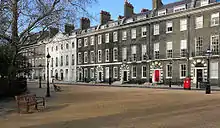
History

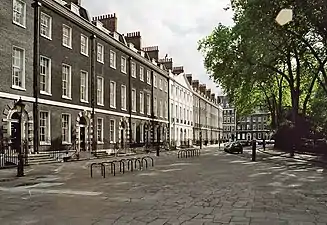

Built between 1775 and 1783 as an upper middle class residential area, the square has had many distinguished residents, including Lord Eldon, one of Britain's longest serving and most celebrated Lord Chancellors, who lived in the largest house in the square for many years.[1] The square takes its name from the main title of the Russell family, the Dukes of Bedford, who owned much of the land in what is now Bloomsbury.[2]
The architect Thomas Leverton is known to have designed some of the houses, although he may not have been responsible for all of them.[3]
The building agreements for Bedford Square were signed by the trustees of the late Duke of Bedford and William Scott and Robert Grews, the builders, in 1776.[4] The first leases, for the entire west side (Nos. 28-39), were granted in November 1776. It seems unlikely that these dozen houses were built within 11 months so building probably started in 1775. Except for No. 46, the south side leases were granted in 1777, the east side in 1777 and 1778 (except Nos. 1 and 10), and the north side in 1781 and 1782 (except Nos. 24-27, granted in 1777). No. 11, which stands in Gower Street but has always been considered part of the square, had a separate building agreement of 1781 and was leased in June 1783.[5]
The leases were granted by the estate once the shells were built but with internal finishing still to be carried out. No. 23 was the last house to be occupied, its owner moving in during the last quarter of 1784.[6]
The delay in finishing the building of the square can be put down in part to the shortage of money during the American War of Independence. Loans were granted by the trustees of the estate to the builders in order to finance building work from November 1777.[7]
Conservation
Bedford Square is one of the best preserved set pieces of Georgian architecture in London, but most of the houses have now been converted into offices.[8] Numbers 1-10,[3] 11,[9] 12–27,[10] 28–38[11] and 40–54 are grade I listed buildings.[12]
Garden
The central garden remains private, but is opened to the public as part of the Open Garden Squares Weekend.[8] The square is Grade II* listed on the Register of Historic Parks and Gardens.[13]
Former occupants
Bedford College, the first place for female higher education in Britain, was originally located in (and named after) Bedford Square (No. 47).
- No. 1: Sir Lyonel Lyde Bt., first occupier of the building for ten years until his death in 1791[3]
- No. 4: Paul Weidlinger – structural engineer[14]
- No. 6: Lord Eldon — Lord Chancellor[1]
- No. 8: Frederick Warne & Norman Warne — publishers, of Frederick Warne & Co., who published the Beatrix Potter books[15]
- No. 10:
- Samuel Lyde (brother of Sir Lyonel at No. 1)[3]
- Charles Gilpin — MP[16]
- No. 11: Henry Cavendish — scientist[17]
- No. 13: Harry Ricardo — engine designer — born here[18]
- No. 22: Johnston Forbes-Robertson — actor[19]
- No. 26: National Council for Voluntary Organisations, 1928 – 1992[20]
- No. 30: Jonathan Cape — publishing company[21]
- No. 35: Thomas Hodgkin — physician, reformer and philanthropist[22]
- No. 35: Thomas Wakley — founder of The Lancet[23]
- No. 36: Thomas Wilkinson King — pathologist[24]
- No. 41:
- William Butterfield — architect[25]
- Sir Anthony Hope Hawkins — novelist[26]
- No. 44:
- Ottoline Morrell — socialite[27]
- Margot Asquith — wife of the Prime Minister H. H. Asquith[28]
- No. 48: Elizabeth Jesser Reid — anti-slavery activist and founder of Bedford College for Women[29]
- No. 49: Francis Walker — entomologist; before that Ram Mohan Roy — Indian scholar and reformer[30]
- No. 52: — used as the contestants' house in the 2010 series of The Apprentice[31]
See also
Other squares on the Bedford Estate in Bloomsbury included:
References
- Riley, W Edward; Gomme, Laurence (1914). "'Nos. 6 and 6A, Bedford Square', in Survey of London: Volume 5, St Giles-in-The-Fields, Pt II". London. pp. 154–156. Retrieved 18 July 2018.
- Riley, W Edward; Gomme, Laurence (1914). "'Bedford Square (general)', in Survey of London: Volume 5, St Giles-in-The-Fields, Pt II". London. pp. 150–151. Retrieved 18 July 2018.
- Historic England. "Nos 1 to 10 and attached railings (1272304)". National Heritage List for England. Retrieved 25 November 2018.
- Byrne, Andrew (1990). Bedford Square: an architectural study. London and Atlantic Highlands, New Jersey: The Athlone Press. p. 31. ISBN 0 485 11386 4.
- Byrne, Andrew (1990). Bedford Square: an architectural study. London and Atlantic Highlands, New Jersey: The Athlone Press. p. 40. ISBN 0 485 11386 4.
- Byrne, Andrew (1990). Bedford Square: an architectural study. London and Atlantic Highlands, New Jersey: The Athlone Press. p. 41. ISBN 0 485 11386 4.
- Byrne, Andrew (1990). Bedford Square: an architectural study. London and Atlantic Highlands, New Jersey: The Athlone Press. p. 41 and Appendix 2, p156. ISBN 0 485 11386 4.
- "Bedford Square". www.opensquares.org. Archived from the original on 27 November 2018. Retrieved 26 November 2018.
- Historic England. "Number 11 and Attached Railings (1272315)". National Heritage List for England. Retrieved 19 November 2017.
- Historic England. "Numbers 12-27 and Attached Railings (1244546)". National Heritage List for England. Retrieved 19 November 2017.
- Historic England. "Numbers 28-38 and Attached Railings (1244548)". National Heritage List for England. Retrieved 19 November 2017.
- Historic England. "Numbers 40-54 and Attached Railings (1244553)". National Heritage List for England. Retrieved 19 November 2017.
- Historic England, "Bedford Square (1000245)", National Heritage List for England, retrieved 19 November 2017
- Weidlinger, Tom. "Beauty, art and the shape of things to come". restlesshungarian.com. Retrieved 10 March 2018.
- Owen, William Benjamin (1912). . In Lee, Sidney (ed.). Dictionary of National Biography (2nd supplement). 3. London: Smith, Elder & Co. pp. 594–595.
- 10, Bedford Square is the address of his letter to the Editor of The Times, Tuesday, 26 October 1858; p. 4; Issue 23134; col E. Letters before that date are from 5, Bishopsgate without.
- "Cavendish, Henry (1731-1810)". English Heritage. Retrieved 18 July 2018.
- "Ricardo, Sir Harry (1885-1974)". English Heritage. Retrieved 18 July 2018.
- "Johnston Forbes-Robertson black plaque in London". Blue plaques. Retrieved 18 July 2018.
- "National Council for Voluntary Organisations". National Archives. Retrieved 18 July 2018.
- "Jonathan Cape –". Harrington Books. Archived from the original on 19 July 2018. Retrieved 18 July 2018.
- "Hodgkin, Thomas (1798-1866)". English Heritage. Retrieved 18 July 2018.
- "Wakely, Thomas (1795-1862)". English Heritage. Retrieved 18 July 2018.
- "Dr. T. W. King (1809–47)". Nature. 159 (4037): 365. 15 March 1947. doi:10.1038/159365a0.
- "Butterfield, William (1814-1900)". English Heritage. Retrieved 18 July 2018.
- "Hawkins, Anthony Hope (1863-1933)". English Heritage. Retrieved 18 July 2018.
- "Lady Ottoline Morrell". Open Plaques. Retrieved 18 July 2018.
- "Margot Asquith, socialite and author, wife of Liberal Prime Minister H. H. Asquith. Autograph Note Signed ('Margot Oxford') acknowledging receipt of a letter and a book". Richard Ford Manuscripts. Retrieved 18 July 2018.
- "Elizabeth Jesser Reid". Blue Plaques. Retrieved 18 July 2018.
- The Annals and Magazine of Natural History. 18. 1846. p. 143. Retrieved 18 July 2018.
- "Bedford Square". Urban75. Retrieved 18 July 2018.
Blue plaques
A number of houses have blue plaques recording famous residents:
 Harry Ricardo
Harry Ricardo Thomas Hodgkin
Thomas Hodgkin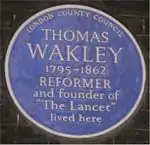 Thomas Wakley
Thomas Wakley Anthony Hope Hawkins
Anthony Hope Hawkins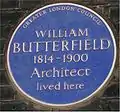 William Butterfield
William Butterfield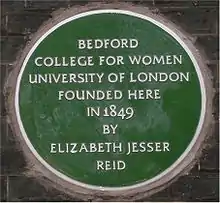 Elizabeth Jesser Reid
Elizabeth Jesser Reid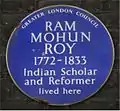 Ram Mohan Roy
Ram Mohan Roy Lord Eldon
Lord Eldon
- Plaquemap.com London blue plaque scheme — For exact location of these plaques within the square.